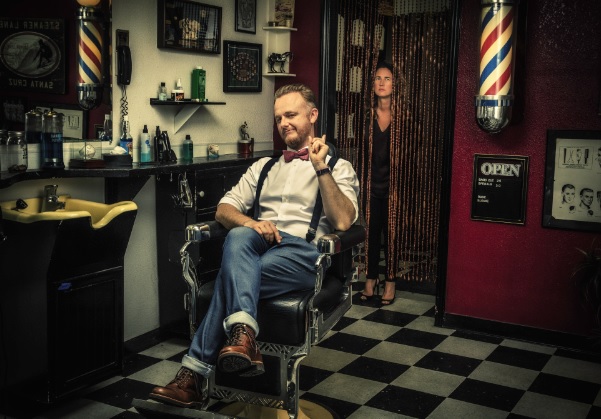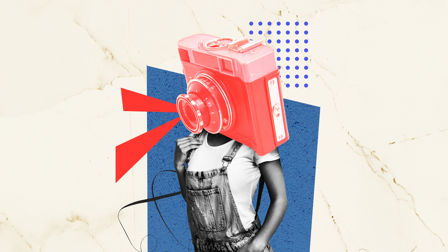Inside the World of Intel
Yogiraj Graham and Teresa Herd are two of the brains that power the creative thinking that makes Intel's advertising a force to be reckoned with.
While the world dismissed Intel as a moderately dull computer chip maker, the company has been amassing a portfolio of distinctly not-dull projects, such as powering space craft, fixing backpacks to bees and collaborating on cultural gems, from animations to drone light shows. Kate Hollowood speaks to VP-global creative director, Teresa Herd, and director of Intel Global Production Labs, Yogiraj Graham, about sharing Intel’s inside jobs with the outside world
It must be every creative director’s dream. With projects ranging from powering space craft to sewing machines, saving the environment to empowering communities with coding, Intel has been behind a gold mine of untold stories. “I don’t think I knew what a treasure I was walking into,” says Teresa Herd, who joined the brand to head up its new internal creative unit, Agency Inside, in 2014. “If it turns on, you can assume that somewhere Intel powered that piece of technology.”
TBWAChiatDay LA rev up B2B
“B2B is a category that can be boring, impersonal and dry because it’s people talking to businesses rather than people talking to people,” says Linda Knight, ECD at TBWAChiatDay LA. “We’re trying to change that.” Impressed by this commitment to talk to business people in more human terms, Intel appointed the company as its global B2B creative agency in 2016.
An initial series of spots feature the future personified as a man. After discovering that 45 per cent of business leaders worry they’ll be obsolete in three to five years, the agency saw an opportunity for Intel to help ease their anxieties. The films show the future reassuring the troubled people he encounters that we have a brilliant world to look forward to, ending with the line ‘We know the future, we’re building it’.
More recently, TBWAChiatDay LA has produced a series of highly relatable and amusing films about life at work, showing critical situations where technology needs to work as it should. The agency is also exploring how Intel’s AI capabilities could help demonstrate and explain the opportunities the technology offers to businesses. “We’re using technology to sell technology,” says Linda. “We all want to make things that go beyond film. From the onset of our partnership, Intel’s CMO Steve Fund has pushed us not to do traditional B2B advertising.”
Launched in 1991, the company’s Intel Inside campaign positioned its semiconductor chip as a vital component of the personal computer market, transforming the brand into a household name. It made itself relevant to even the most tech illiterate, who have looked out for the Intel Inside label ever since when buying a new computer. However, Intel was trying to move away from being a PC-centric company and towards becoming a data-centric one. “We thought it was time to rebrand,” says Herd. “There was a very big turning point three years ago when we decided to stop looking inward and start telling the story of how we power these experiences on the outside.”
“There was a very big turning point three years ago, when we decided to stop looking inward and start telling the story of how we power these experiences on the outside.”
Working alongside the brand’s internal production team, Intel Global Production Labs, Agency Inside created a series of online films, Meet the Makers, that demonstrate the varied impact Intel products have on the world. In all the films the human – rather than the technological – story takes centre stage. For example, one film turns the spotlight on the inventor of a connected glove that can predict an epileptic attack. Rajlakshmi Borthakur’s epileptic son suffered such severe attacks that he was left permanently brain damaged.
Feeling powerless to help him, she spent three and a half years researching the disease and came up with the idea of a simple glove that could pick up vital bio-data signs – processed swiftly by the powerful Intel Edison – and signal that an attack was imminent. As she says, “What wouldn’t a mother do to save her son?” Another film features backpack-wearing bees, or rather, bees fitted with tiny RFID tags connected to Intel Edison. The technology gathers data about what the bees are doing each day, allowing scientist Dr Paulo De Souza to measure any stress factors. “This is not about bees or microchips or technology,” says De Souza. “This is about the future of our planet.”
Going Gaga over dancing drones
In order to truly become an experience brand, Intel has to behave like one. “Consumers are too savvy,” says Herd. “It’s not just a matter of changing our tagline, we actually have to do these things.”
Enter Lady Gaga, 300 drones and the biggest broadcast event of the year. For the 2017 Super Bowl halftime show, Intel collaborated with the singer and Pepsi to light up the skies with twinkling LED-fitted drones, built from scratch for the event and dubbed the Intel Shooting Star. Flying around in perfect synchronicity, the drones moved in various formations, culminating in the American flag. The display introduced 150 million viewers to a new application for the technology, as well as a fresh definition of Intel.
Mcgarrybowen big up the bong
Mcgarrybowen was named Intel’s global lead agency in 2015, winning the business with the idea ‘Experience what’s inside’. “We changed the paradigm from it being an ingredient brand to an experience brand,” says Marianne Besch, MD and ECD of mcgarrybowen.
In 2016, this new idea was launched with the Experience Amazing film, a montage of Intel-powered experiences – ranging from a DreamWorks animation to using a prosthetic limb – set to music that mashed up Intel’s iconic five-note bong with Beethoven’s 5th Symphony, arranged by Walter Werzowa, who composed the original jingle.
Further work includes a series of comic spots starring The Big Bang Theory’s Jim Parsons, in which he urges real-life sporting heroes to upgrade their equipment. The campaigns have all raised the brand’s stock in actual terms: according to the BrandZ Top 100 Most Valuable Global Brands rankings, compiled by Kantar Millward Brown, Intel’s rating has skyrocketed from 86 in 2014 to 44 in 2017.
“Intel is a partner not a client,” says Besch. “Teresa and I joke that we share a brain cell, it’s a great collaboration.” She believes this culture breeds creative success. “When there is trust in a collaborative environment, creatives push themselves further,” she says. “When you love what you do, it shows in the work.”
The Super Bowl halftime show epitomises the kind of work Agency Inside is creating to redefine the brand. “Intel makes amazing products, often for very specific-use cases, so we’ll work with the business to see how we can stretch the bounds of potential creative applications,” explains Herd. Her team creates new products, based on the brand’s existing technology, that will show off the company’s capabilities in the most engaging way. For example, she is working on applying the drone tech used to assess oil rigs to environmental projects such as monitoring whales.
The super steady drones are designed to survive strong winds, making them the perfect tool to capture data about cetaceans. “It’s about understanding how the tech works and how it might be able to be repurposed or reimagined,” says Yogiraj Graham, director of Intel Global Production Labs. “Being at Intel has really changed the way that I think about creativity, because we have to understand what we actually do as a company.”
“If you’re curious, [working in-house] really draws you into the innovation that’s at the heart of Intel. It makes you a steward of the brand and the messaging in a way that you wouldn’t be if you were on the outside.”
Sharing the same offices as the rest of the company, the agency is able to get much closer to the technology and the people creating it, making it easier to spot opportunities. “If you’re curious, [working in-house] really draws you into the innovation that’s at the heart of Intel. It makes you a steward of the brand and the messaging in a way that you wouldn’t be necessarily if you were on the outside,” Graham says.

The power of collaboration
Despite bringing the majority of its creative work in-house, Intel still works with select agencies. In fact, mcgarrybowen worked with the brand on the Super Bowl light show campaign, creating the TV commercial. “We were all on set together, and if you were to show up, you would not have known where mcgarry stopped and where my team started,” says Herd. “We work with a handful of partners who we really trust and who understand what our goals are, and are comfortable with working that way. Not every agency is.”
This means that occasionally her team ends up pitching against mcgarrybowen or Intel’s global B2B agency of record, TBWAChiatDay. “But once we decide on the ideas, the teams really work together. You’re not going to waste time on a shoot day arguing over whose turn it is.”
Herd fully realised the power of Intel’s collaborative approach at Cannes, after winning a gold Lion for the Super Bowl halftime drone show. As everyone involved gathered to celebrate the success, Herd found herself surrounded by a strikingly diverse array of talent. Together they’d created a whole new product, launched it with spectacular creativity and packaged it up in a captivating story. “I remember looking around and thinking, ‘Wow, there are very few companies who can do this,’” she says. “That was a bit of an ‘Aha!’ moment. We’re not doing this alone.”
)






 Membership
Membership



